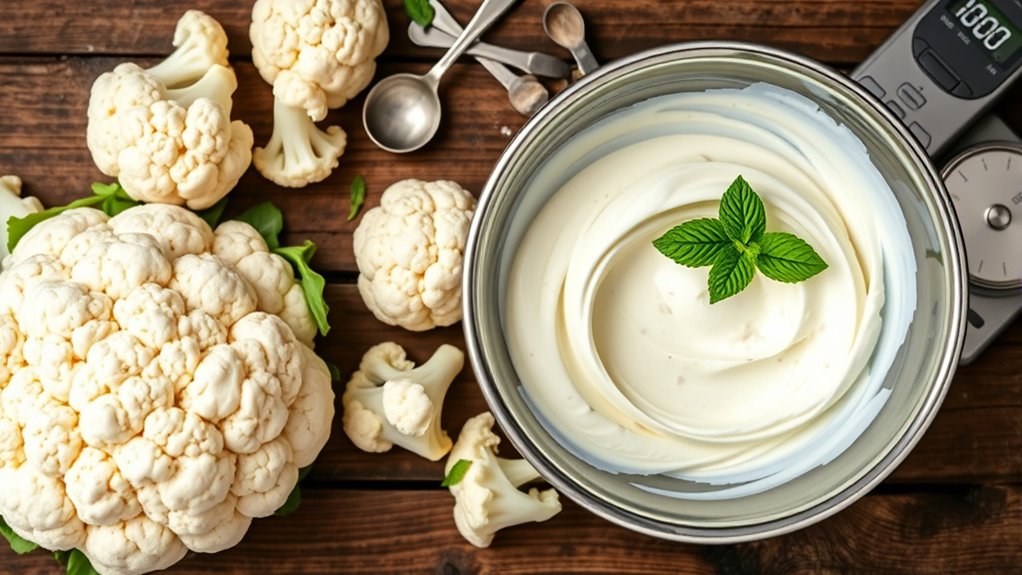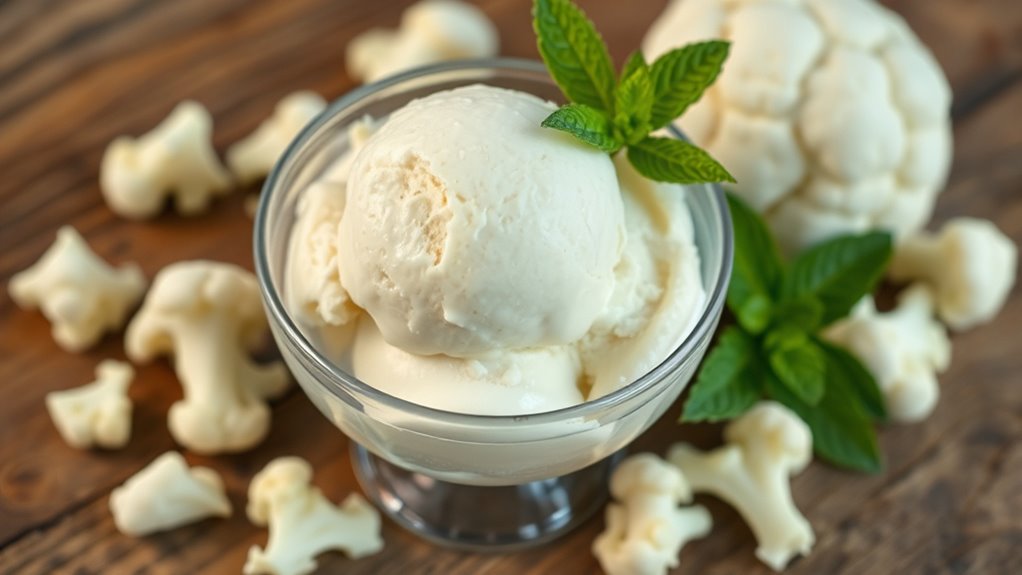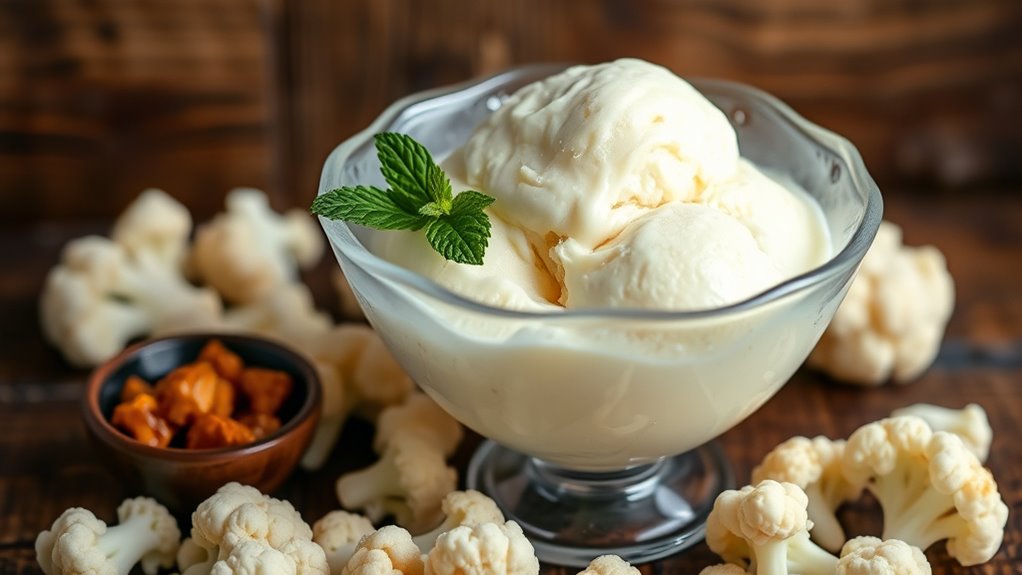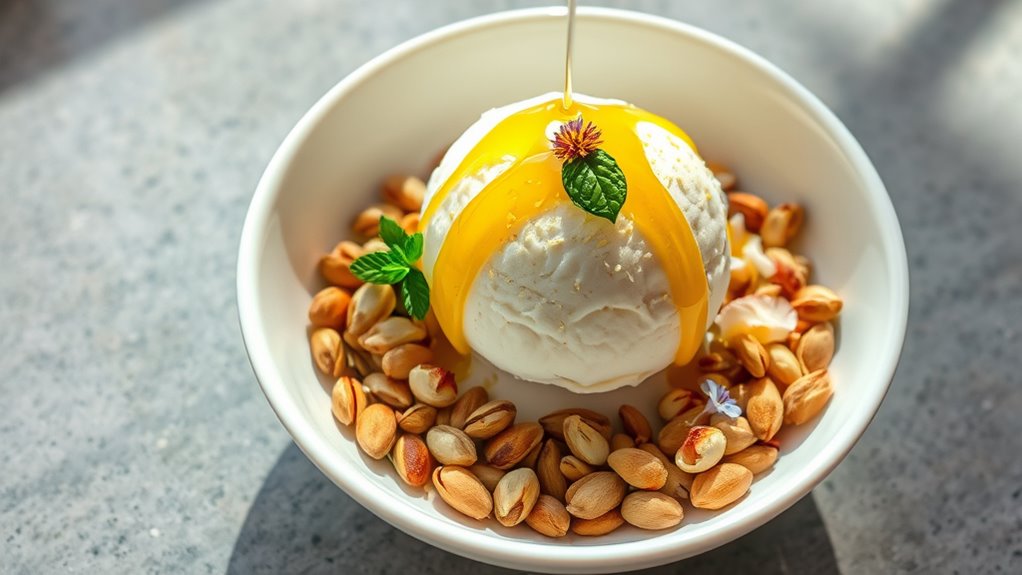You’ll craft a creamy, dairy-free cauliflower ice cream by starting with well-drained, blanched florets, then blending steamed pieces with a neutral base and a touch of sweetness. Use precise measurements, pulse in short bursts to avoid graininess, and chill the mix before churning for stability. Serve slightly chilled with texture contrast like nuts or coconut. A precise prep and method boost creaminess and flavor, and you’ll discover more tweaks as you continue.
Ingredients and Quantity

For this cauliflower ice cream, you’ll start with a straightforward base of one medium head of cauliflower, 1 cup of milk (or you can use a dairy-free alternative), and 2 tablespoons of honey or maple syrup to sweeten. You’ll tailor quantities by batch size and flavor goals, mindful of texture and nutrition evidence. Cauliflower varieties influence creaminess and moisture, guiding your choices for ice cream flavors. Use the table below to compare options and keep your plan data-driven.
| Variety | Benefit | Link to flavor |
|---|---|---|
| Classic white | Neutral base | Subtle sweetness |
| Purple | Color, antioxidants | Berry hints |
| Orange | Vitamin A boost | Caramel tones |
Preparations

Begin by prepping the cauliflower thoroughly: remove the leaves and stem, break the florets into even chunks, and rinse under cold water. You’ll then weigh heads, trim uneven pieces, and blot dry to minimize excess moisture. This step sets a reliable baseline for texture and creaminess. In this phase, you’ll evaluate preparation techniques that influence final mouthfeel, such as blanching versus roasting, and choose methods that suit your time frame and flavor goals. Evidence shows blanching preserves pale color and mild sweetness, while roasting adds depth and nutty notes. Consider ingredient substitutions for dietary needs or availability, like coconut milk, almond yogurt, or dairy-free milks, and document each swap’s impact on texture and sweetness. Proper prep improves consistency and flexibility across batches.
How to Cook

- Prep your cauliflower by washing and cutting it into florets.
- Choose a cooking method that preserves moisture and minimizes browning to optimize creaminess.
- Steam the cauliflower until tender to keep nutrients intact; this is ideal for creating a smooth purée.
- Blanch the cauliflower briefly if you need to reset its texture after overprocessing.
- For richer flavors, gently roast the cauliflower before puréeing to add caramelized complexity without adding excessive fat.
- Pulse the cauliflower in short bursts when blending, allowing rests between pulses to reduce heat-driven graininess.
- Avoid using sugary additives; rely on cauliflower’s natural sweetness for a healthier alternative.
- Adjust heat, cooking duration, and the sequence of steps carefully to achieve consistent, desirable results.
How to Serve

Cauliflower ice cream should be served slightly chilled to maintain stability and a rejuvenating finish; you can portion it into single-serving scoops for neat presentation. When plating, pair with serving suggestions that highlight texture contrasts, such as crunchy nuts, toasted coconut, or a drizzle of honey to enhance sweetness without overpowering the base. Temperature contrast matters: slightly warmer toppings can create a dynamic eating experience while the core remains firm. Dessert accompaniments should support the flavor profile—think citrus zest for brightness or berry coulis for acidity balance. Use simple garnishes like mint or edible flowers to elevate aesthetics without overpowering the ice cream. Keep portions modest to sustain the invigorating, dairy-free perception and promote repeat servings.
Tips

To maximize texture and flavor in your cauliflower ice cream, start with well-drained, thoroughly blanched florets to lighten the base and reduce moisture that can curb creaminess. In practice, measure ingredients precisely and chill your mix before churning to improve stability. Use a neutral fat base (cream or coconut cream) and balance with a touch of sugar or sweetener to optimize mouthfeel. For flavor accuracy, add extracts or spices late in mixing to preserve aroma. When testing, document results: note sweetness, body, and aftertaste, then adjust fat and stabilizers accordingly. Flavor combinations shine with contrasting notes like vanilla-citrus or cinnamon-ginger. Texture variations emerge by varying churn time and fat content; shorter churning yields denser, longer yields lighter, more scoopable ice cream.
Food Value and Benefit
Cauliflower ice cream offers a nutritious alternative to traditional dairy desserts, combining flavor with valuable health benefits. This recipe provides a lower-calorie option thanks to its vegetable base, making it easier to enjoy a satisfying treat while managing calorie intake. The cauliflower adds dietary fiber, promoting digestive health and helping you feel full longer. Additionally, the ice cream contains essential vitamins and minerals such as vitamin C, calcium, and potassium, which support immune function, bone strength, and overall wellness. By choosing light dairy or plant-based ingredients, you can reduce saturated fat intake, aligning the dessert with heart-healthy and weight management goals. This versatile recipe allows you to customize sweetness and texture while maintaining a nutrient-rich indulgence suitable for an active lifestyle.
Benefits of eating cauliflower ice cream:
- Lower calorie content due to vegetable base and fiber
- Provides dietary fiber supporting gut health and satiety
- Contains vitamin C for immune support
- Supplies calcium to promote bone health
- Includes potassium to help regulate blood pressure
- Can be adapted to dairy-free or reduced-sugar preferences
- Offers a lower saturated fat option when using light or plant-based dairy alternatives
Frequently Asked Questions
Can I Use Frozen Cauliflower Instead of Fresh?
Yes, you can. Juxtapose frozen texture with fresh results, then assess notes: frozen texture may alter creaminess, but nutrition remains similar; nutritional comparison shows comparable calories and fiber. You’ll feel freedom choosing frozen when time’s tight and convenient.
Is This Dairy-Free or Lactose-Free?
This dairy-free option depends on the recipe; many versions use dairy-free milk or coconut cream, making it lactose-free. If you’re lactose intolerant, check labels for dairy alternatives and confirm no hidden lactose in ingredients.
Can I Substitute Almond Milk for Dairy Milk?
Yes, you can substitute almond milk for dairy milk in many recipes, including cauliflower ice cream bases. Almond benefits include lower calories and no lactose; it’s a solid Milk alternative, but watch flavor and texture trade-offs.
How Long Does It Keep in the Freezer?
Freezes well for about 1 to 2 months when properly stored. Use airtight containers and freeze in shallow portions. Storage Tips and Freezing Techniques matter: label date, avoid freezer burn, and stir once after thawing for best texture.
Can I Omit Sugar or Use Alternatives?
A surprising 60% of home bakers report adjusting sweetness for dairy-free desserts. Yes, you can omit sugar or use sugar alternatives; explore sweetener options like stevia, erythritol, or monk fruit, and assess taste with sugar alternatives.
